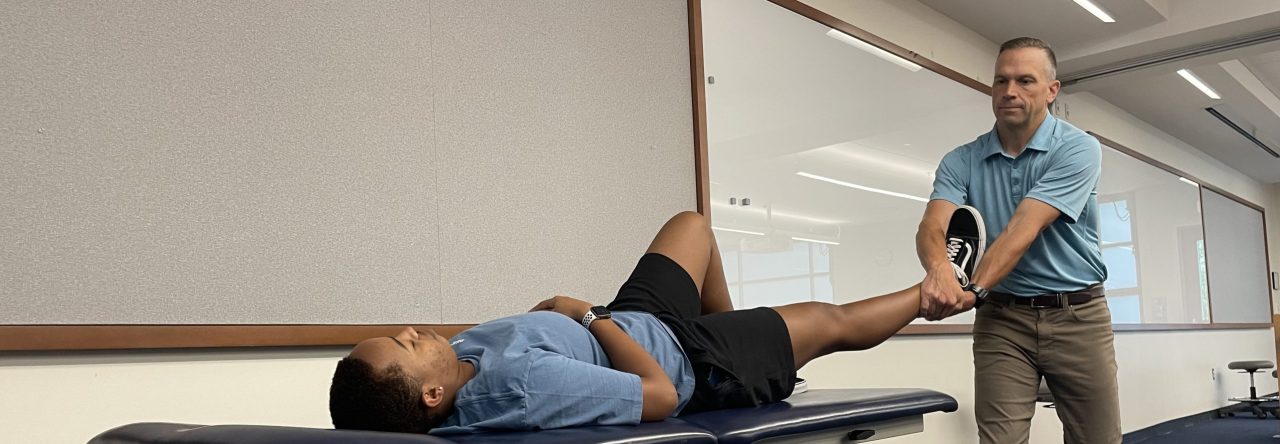The immediate effects of two manual therapy techniques on ankle musculoarticular stiffness and dorsiflexion range of motion in people with chronic ankle rigidity: A randomized clinical trial
Author Names
Hidalgo, Benjamina; * | Hall, Tobyb | Berwart, Mathildec | Biernaux, Elinorc | Detrembleur, Christinec
Reviewer Name
Gabrielle Stanley, Duke SPT2
Reviewer Affiliations
Duke University School of Medicine, Doctor of Physical Therapy Division
Paper Abstract
Ankle rigidity is a common musculoskeletal disorder affecting the talocrural joint, which can impair weight-bearing ankle dorsiflexion (WBADF) and daily-life in people with or without history of ankle injuries. The objective of this study was to compare the immediate effects of efficacy of Mulligan Mobilization with Movement (MWM) and Osteopathic Mobilization (OM) for improving ankle dorsiflexion range of motion (ROM) and musculoarticular stiffness (MAS) in people with chronic ankle dorsiflexion rigidity. In a randomized controlled clinical trial with two arms, patients were recruited by word of mouth and via social network as well as posters, and analyzed in the neuro musculoskeletal laboratory of the “Université Catholique de Louvain-la-Neuve”, Brussels, Belgium. A total of 40 men (n=40) ranging in age from 18-40 years presented with nonspecific unilateral ankle mobility deficits during WBDF were randomly assigned to receive either Mobilization with Movement, MWM, (n=20) or Osteopathic Movement, OM (n= 20) manual therapy on their affected ankle. A two way ANOVA revealed a non-significant interaction between either mobilization technique and time with all outcome measures. Outcome measures included Lehmann’s device to measure musculoarticular stiffness, in terms of elastic stiffness (p=.37), viscous stiffness (p=.83), and total stiffness (p=.58) as well as toe-wall distance (p=.58) and angular range of motion to measure limited WBDF (p=.68). A one-way ANOVVA demonstrated non-significant differences with small to moderate effect sizes (d=.003-.580) on all outcome measures before and after intervention. The only time based, significant interaction between groups that existed was viscous stiffness (p=.04. d=-.55).
NIH Risk of Bias Tool
Quality Assessment of Controlled Intervention Studies
- Was the study described as randomized, a randomized trial, a randomized clinical trial, or an RCT
-
- Yes
- Was the method of randomization adequate (i.e., use of randomly generated assignment)?
-
- Yes
- Was the treatment allocation concealed (so that assignments could not be predicted)?
-
- Cannot Determine, Not Reported, or Not Applicable
- Were study participants and providers blinded to treatment group assignment?
-
- Yes
- Were the people assessing the outcomes blinded to the participants’ group assignments?
-
- Yes
- Were the groups similar at baseline on important characteristics that could affect outcomes (e.g., demographics, risk factors, co-morbid conditions)?
-
- No
- Was the overall drop-out rate from the study at endpoint 20% or lower of the number allocated to treatment?
-
- Yes
- Was the differential drop-out rate (between treatment groups) at endpoint 15 percentage points or lower?
-
- Yes
- Was there high adherence to the intervention protocols for each treatment group?
-
- Cannot Determine, Not Reported, or Not Applicable
- Were other interventions avoided or similar in the groups (e.g., similar background treatments)?
-
- Cannot Determine, Not Reported, or Not Applicable
- Were outcomes assessed using valid and reliable measures, implemented consistently across all study participants?
-
- Yes
- Did the authors report that the sample size was sufficiently large to be able to detect a difference in the main outcome between groups with at least 80% power?
-
- No
- Were outcomes reported or subgroups analyzed prespecified (i.e., identified before analyses were conducted)?
-
- No
- Were all randomized participants analyzed in the group to which they were originally assigned, i.e., did they use an intention-to-treat analysis?
-
- Yes
Key Finding #1
- A single session of Mobilization with Movement and Osteopathic Mobilization at the ankle does not immediately improve measures of joint range of motion or joint musculoarticular stiffness.
Key Finding #2
Viscous stiffness increases in people with a history of ankle injury following Mobilization with Movement and Osteopathic Mobilization; however, this may contribute to prevention of future abnormal ankle kinematics.
Please provide your summary of the paper
Mobilization of the talocrural joint in patients with dorsiflexion rigidity does not appear to improve range of motion immediately. However, the lack of dorsiflexion in the ankle is a direct result of an injury, mobilization may contribute to preventing further abnormal ankle movements. However, it should be noted that this study never clearly defined how many of its participants who possessed “ankle rigidity” acquired said stiffness from an injury. In other words, the concluding key finding may be insignificant if the number of previously injured patients who saw improvements was of an insufficient sample size.
Please provide your clinical interpretation of this paper. Include how this study may impact clinical practice and how the results can be implemented.
It should be noted that despite being listed as a “randomized controlled trial” in PubMed, the study never explicitly states which manipulation technique is considered the control and why. The study often references its findings in comparison to “control groups” but there is no explicit specification of what the control group would be (i.e. perhaps a group of individuals with ankle sprains who received no mobilization or were given general range of motion exercises as opposed to manual therapy) or what studies these referenced control groups are from. This study may lead practitioners to be more inclined to use manual therapy in patients with rigidity due to ankle injuries.I would be curious to see how this study would compare to a control group of individuals who did not receive manual therapy, to see if there is any benefit to manual therapy over autonomous range of motion exercises in patients with ankle rigidity.
